Huawei MateBook X Pro (2021) Review: A Sleek and Vibrant Notebook
by Dr. Ian Cutress on September 28, 2021 9:00 AM EST- Posted in
- Notebooks
- Intel
- Huawei
- Laptops
- Matebook X Pro
- Tiger Lake
Display
On paper, the specifications for the Huawei MateBook X Pro 2021 seem impressive – a 3000x2000 resolution LTPS display that gives a 91% screen-to-body ratio. At a 13.9-inch diagonal, that translates to 260 pixels per inch, which is a key target for devices in this price bracket. Huawei rates the display as a 450 nit brightness with a 1500:1 contrast ratio, which is above a lot of traditional 300 nit displays that sometimes plague this price point. On top of this, Huawei promotes a 100% sRGB gamut for color accuracy, and the screen supports 10-point multi-touch as well as gestures.
As mentioned a few pages prior, because Huawei has moved the webcam from the display to the keyboard, this allows the display to go as far up to the edge of the chassis as Huawei could make it without sacrificing rigidity. Any laptop looks really good when a display almost touches the edge, which when combined with the 450 nit brightness does make the device stand out.
The panel is listed as the Tianma XM TL139GDXP01, and the official specifications match those Huawei has provided.
For our testing today, we’re using the X-Rite i1Display Pro colorimeter.
Brightness and Contast
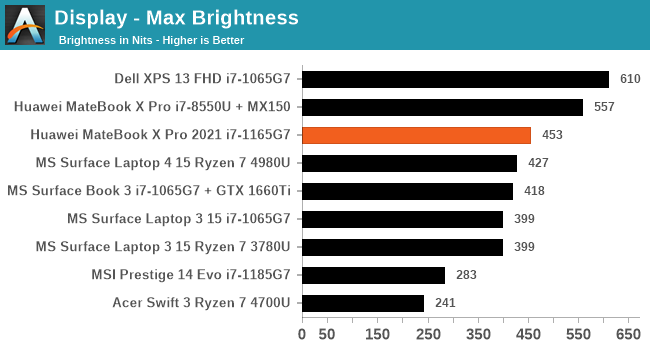
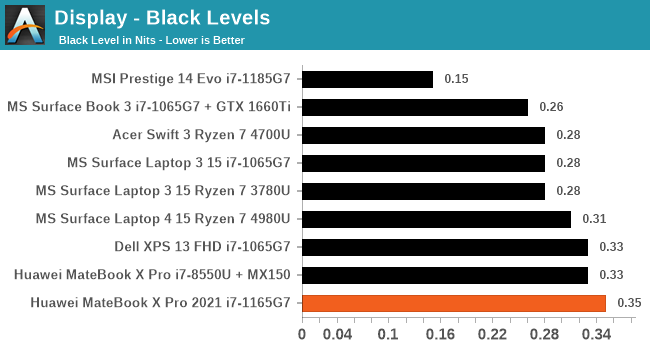

As for maximum brightness, we’re right on specification, however in our testing the black level is certainly higher than other devices in the market, which leads to a lower-than-advertised contrast ratio.
Battery Life
Taking advantage of the bigger-than-13-inch form factor, Huawei has equipped the MateBook X Pro 2021 with a 56 Wh battery, which is about 10-20% bigger than the 45 Wh batteries we see in the smaller size. Without the presence of a discrete GPU, one might argue that this battery should go for a long time, however the high-resolution display might prove to be an Achilles heel. Huawei’s documentation lists a 10 hour battery life for local video playback, which would be just enough for a long haul flight.
For our testing, we calibrate the display as close to 200 nits as we can (in this case, brightness set to 62), and progress through both a movie workload and a web workload. We would have also tested using PCMark’s battery test, however the test would always fail when video decoding, as mentioned previously.
It’s worth noting that Huawei lists the battery as 56 Wh (typical). Our battery reported 55.4 Wh when fully charged.
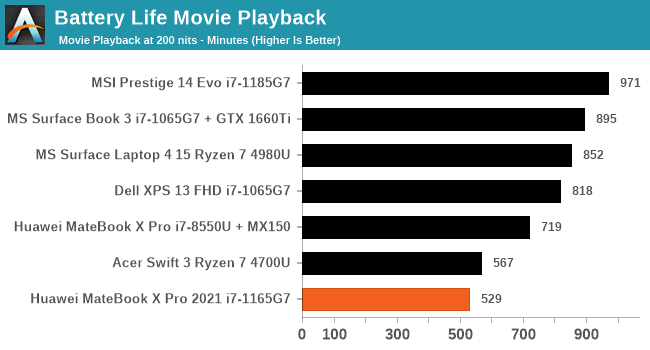
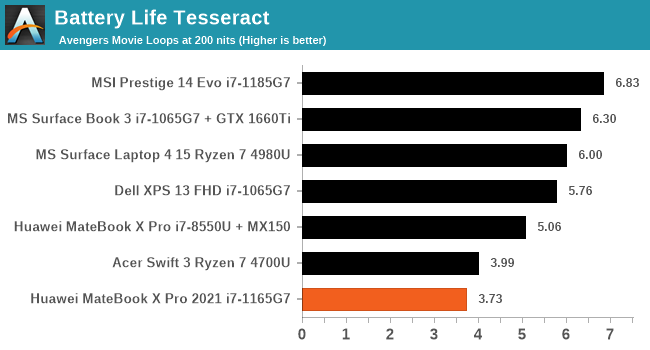
Our movie test at 200 nits is just below the 10 hour mark quoted, however Huawei seems to have done their testing at 150 nits, according to the website. 529 minutes is actually quite low compared to a number of laptops that the MateBook X Pro 2021 competes against.
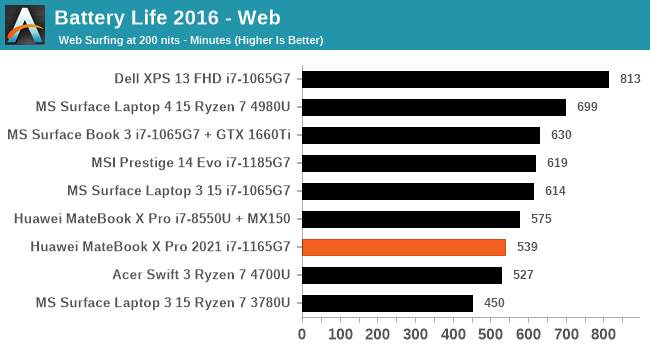
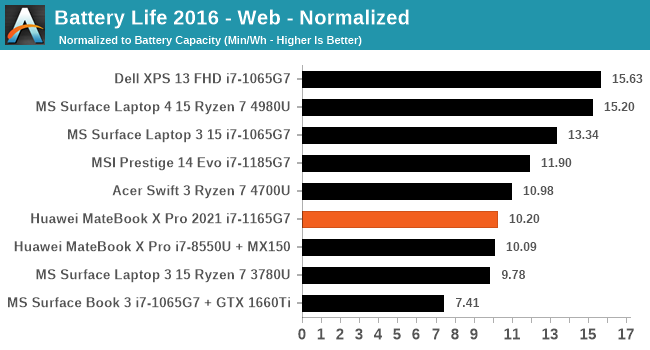
The web test does slightly better than our movie test, even though the screen is doing a lot more whites, but it isn’t having to process so much video. Normalizing for the battery capacity, we get 10.2 minutes per Watt-hour, which again isn’t a great result compared to the previous generation hardware or AMD’s offering.
Charge Time
Huawei ships the laptop with a 65 W charger with a Type-C port, and a C-to-C cable to connect it to the laptop. For our charge test, we discharge the battery down to 5% with a high powered workload, then down to 2% while on idle to cool it down. The system is then plugged it in, set on low power, with the screen still at 200 nits, and then monitored the charge level as reported as a function of time up until the reported charge no longer moved.
As well as our output report, I also put one of these in the loop. It showcased that the laptop was charging around 48-52 W constantly for the first 80 minutes or so, at 20 V / 2.5 A.
For our charge profile, we achieved:
- 2% to 10% charge in 7 minutes
- 2% to 65% charge in 60 minutes
- 2% to 90% charge in 87 minutes
- 2% to 100% charge in 110 minutes
Even though the charger is listed as 65 W capable, I didn’t see it ever go up to 65 W.
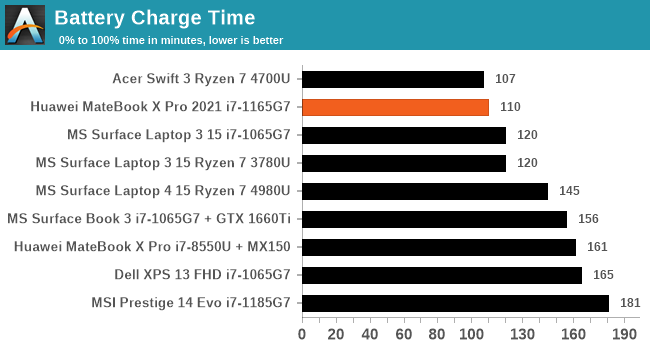


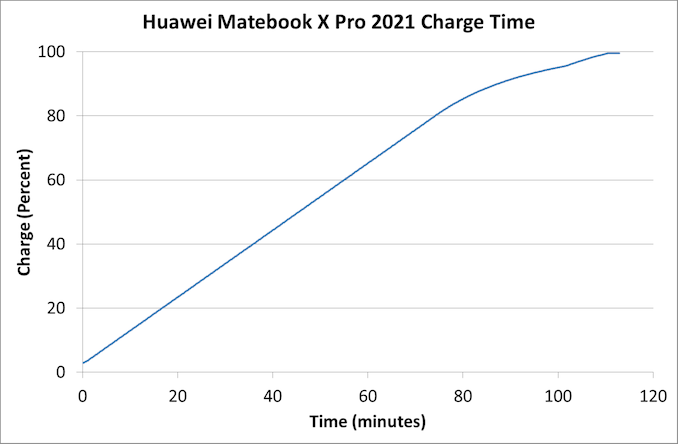








84 Comments
View All Comments
Prestissimo - Thursday, September 30, 2021 - link
https://arstechnica.com/information-technology/202...vladx - Thursday, September 30, 2021 - link
Just more FUD, it's common knowledge that Lithuania has a bone to pick with China.DougMcC - Thursday, September 30, 2021 - link
Sure, if you consider government advisories baseless. Be sure to avoid that covid vaccination!vladx - Thursday, September 30, 2021 - link
You bet, still unvaccinated to this day while at the same time managing to not get infected even once. If you are careful enough to sanitize your hands thoroughly like I am you don't need any vaccine.Wereweeb - Thursday, September 30, 2021 - link
"US accuses Huawei of spying" the first was caught dozens of times spying on everyone, including their own citizens. The second is accused every couple of months and I never hear of any evidence popping up. HmmmmmmmDougMcC - Thursday, September 30, 2021 - link
That just establishes the credibility of the US as an expert on spying ...DougMcC - Wednesday, September 29, 2021 - link
My first thought as well 'which generation of spy chips does it include'?ikjadoon - Wednesday, September 29, 2021 - link
Looks decent besides the battery life & lack of Thunderbolt 3. On any $1000 base MSRP Tiger Lake design, TB3 should be standard. Likewise, why does it list LPDDR4X-3733 when TGL-U supports 4266?Alas, if we're comparing it to MacBooks, we should try to bring in macOS devices to the standard AnandTech notebook bench suite. Software, I'll figure it out, but getting a late-model MacBook (preferably Arm / M1) as a comparison would let us, the reader, really see these comparisons.
But, the price: wow. I don't know where the money has gone, but TB3 + higher system efficiency should really be expected at this price point. It's a pricey laptop--besides gaming and workstations, it lives in the highest price bracket for Windows PCs.
I am quite glad, however, to see Huawei maintain their 3:2 displays: 16:9 needs alternatives in every segment.
QueBert - Thursday, September 30, 2021 - link
I DJ and make music, I bought an Asus Zenbook 13, after a few months with it I wish to hell I'd waited for M1 support to be added to the software I used. This thing cost the same as an M1 Air, I'm most annoyed at how the fan will often times spin relentlessly even when I'm doing nothing. And even though it's only 2 months old, apparently it's already lost 30% of it's value so if I wanted to try and sell it I'd lose my ass.Wereweeb - Thursday, September 30, 2021 - link
Upgradeability? Repairability?